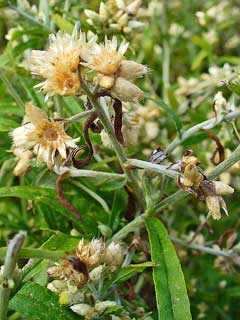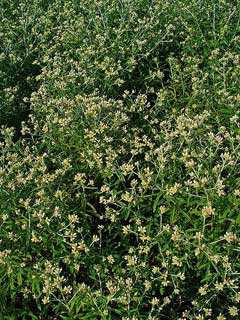 |
|
http://commons.wikimedia.org/wiki/User:Llez |
 |
| http://commons.wikimedia.org/wiki/User:Llez |
Translate this page:
Summary
Physical Characteristics

 Pseudognaphalium obtusifolium is a ANNUAL growing to 0.5 m (1ft 8in). It is in flower from September to October. The species is hermaphrodite (has both male and female organs) and is pollinated by Insects.
Pseudognaphalium obtusifolium is a ANNUAL growing to 0.5 m (1ft 8in). It is in flower from September to October. The species is hermaphrodite (has both male and female organs) and is pollinated by Insects.
Suitable for: light (sandy) and medium (loamy) soils and prefers well-drained soil. Suitable pH: mildly acid, neutral and basic (mildly alkaline) soils. It cannot grow in the shade. It prefers dry or moist soil.
UK Hardiness Map
US Hardiness Map
Synonyms
Gnaphalium obtusifolium. L. G. polycephalum. Michx.
Plant Habitats
Woodland Garden Sunny Edge;
Edible Uses
References More on Edible Uses
Medicinal Uses
Plants For A Future can not take any responsibility for any adverse effects from the use of plants. Always seek advice from a professional before using a plant medicinally.
Anaphrodisiac Antiphlogistic Antispasmodic Astringent Diaphoretic Diuretic Expectorant Sedative
Vermifuge
The whole plant is anaphrodisiac, antiphlogistic, astringent, diaphoretic, expectorant, vermifuge[4, 61]. It is used internally in the treatment of throat ulcers, chest complaints, intestinal and respiratory catarrh etc and is also applied externally as a poultice to bruises, indolent tumours etc[4, 254]. A tea made from the leaves and flowers is a mild nerve sedative, diuretic and antispasmodic[222]. The fresh juice is considered to be aphrodisiac[222]. It is anaphrodisiac according to another report[4]. The aromatic dried flowers are used as a filling for pillows, having a sedative effect which is beneficial to consumptives[4]. A homeopathic remedy is made from the plant[4]. This has proved to be of benefit in the treatment of sciatica, lumbago and some forms of arthritis[4].
References More on Medicinal Uses
The Bookshop: Edible Plant Books
Our Latest books on Perennial Plants For Food Forests and Permaculture Gardens in paperback or digital formats.

Edible Tropical Plants
Food Forest Plants for Hotter Conditions: 250+ Plants For Tropical Food Forests & Permaculture Gardens.
More

Edible Temperate Plants
Plants for Your Food Forest: 500 Plants for Temperate Food Forests & Permaculture Gardens.
More

More Books
PFAF have eight books available in paperback and digital formats. Browse the shop for more information.
Shop Now
Other Uses
Repellent Stuffing
The plant is used as an insect repellent, it is placed in bedmats, books etc[178] and in the linen cupboard[207]. The flower heads are used as a stuffing material for mattresses[207].
Special Uses
Scented Plants
References More on Other Uses
Cultivation details
Requires a dry soil in an open sunny position[200]. Plants are sometimes grown in the wild garden[200]. The leaves have a pleasant aromatic smell and an aromatic, slightly bitter, astringent agreeable taste[4].
References Carbon Farming Information and Carbon Sequestration Information
Temperature Converter
Type a value in the Celsius field to convert the value to Fahrenheit:
Fahrenheit:
The PFAF Bookshop
Plants For A Future have a number of books available in paperback and digital form. Book titles include Edible Plants, Edible Perennials, Edible Trees,Edible Shrubs, Woodland Gardening, and Temperate Food Forest Plants. Our new book is Food Forest Plants For Hotter Conditions (Tropical and Sub-Tropical).
Shop Now
Plant Propagation
Seed - sow spring in a cold frame. When they are large enough to handle, prick the seedlings out into individual pots and plant them out in early summer.
Other Names
If available other names are mentioned here
Native Range
NORTHERN AMERICA: Canada (Québec (south), Nova Scotia, Ontario (southeast), Prince Edward Island, New Brunswick), United States (Connecticut, Indiana, Maine, Massachusetts, Michigan, New Hampshire, New Jersey, New York, Ohio, Pennsylvania, Rhode Island, Vermont, West Virginia, Illinois, Iowa, Kansas, Minnesota (east), Missouri, Nebraska (east), Oklahoma, Wisconsin, Alabama, Arkansas, Delaware, Florida, Georgia, Kentucky, Louisiana, Maryland, Mississippi, North Carolina, South Carolina, Tennessee, Virginia, Texas)
Weed Potential
Right plant wrong place. We are currently updating this section.
Please note that a plant may be invasive in one area but may not in your area so it's worth checking.
Conservation Status
IUCN Red List of Threatened Plants Status :

Growth: S = slow M = medium F = fast. Soil: L = light (sandy) M = medium H = heavy (clay). pH: A = acid N = neutral B = basic (alkaline). Shade: F = full shade S = semi-shade N = no shade. Moisture: D = dry M = Moist We = wet Wa = water.
Now available:
Food Forest Plants for Mediterranean Conditions
350+ Perennial Plants For Mediterranean and Drier Food Forests and Permaculture Gardens.
[Paperback and eBook]
This is the third in Plants For A Future's series of plant guides for food forests tailored to
specific climate zones. Following volumes on temperate and tropical ecosystems, this book focuses
on species suited to Mediterranean conditions—regions with hot, dry summers and cool, wet winters,
often facing the added challenge of climate change.
Read More
Expert comment
Author
(L.)Hilliard.&Burtt.
Botanical References
43200
Links / References
For a list of references used on this page please go here
Readers comment
| Add a comment |
|
If you have important information about this plant that may help other users please add a comment or link below. Only comments or links that are felt to be directly relevant to a plant will be included. If you think a comment/link or information contained on this page is inaccurate or misleading we would welcome your feedback at [email protected]. If you have questions about a plant please use the Forum on this website as we do not have the resources to answer questions ourselves.
* Please note: the comments by website users are not necessarily those held by PFAF and may give misleading or inaccurate information.
To leave a comment please Register or login here All comments need to be approved so will not appear immediately.
|
Subject : Pseudognaphalium obtusifolium
|
|
|
|